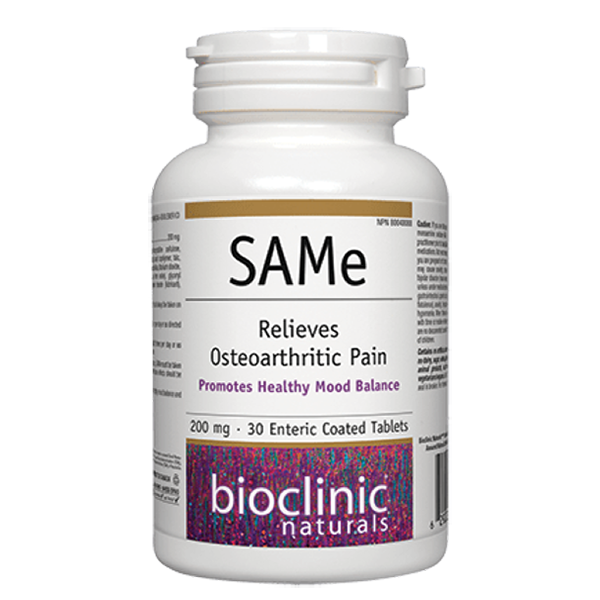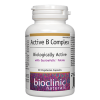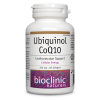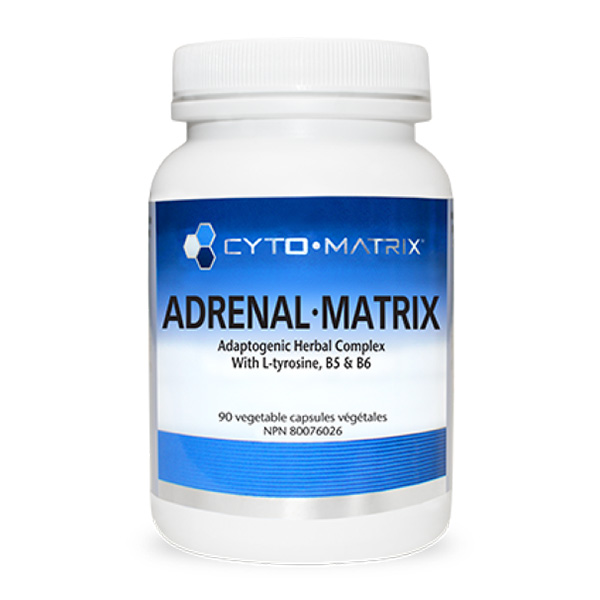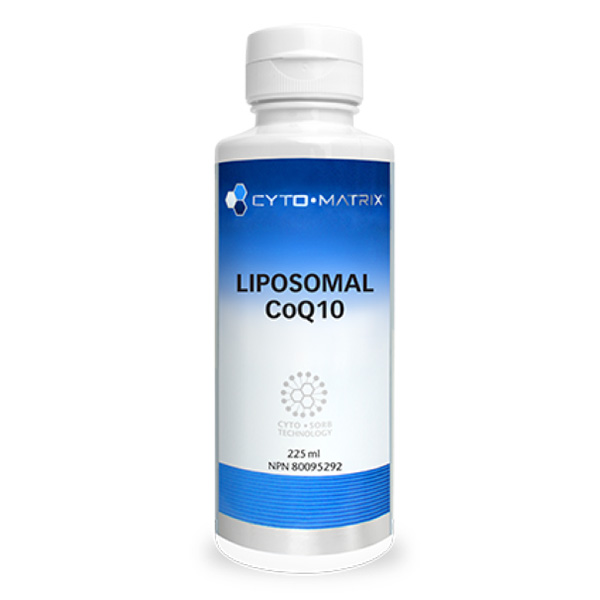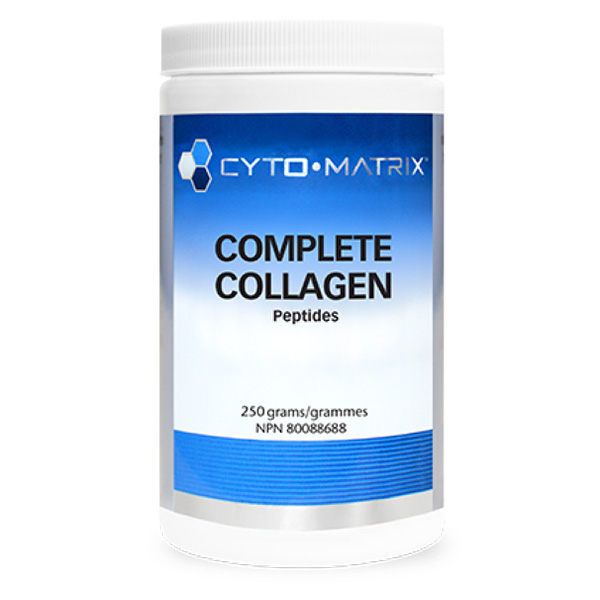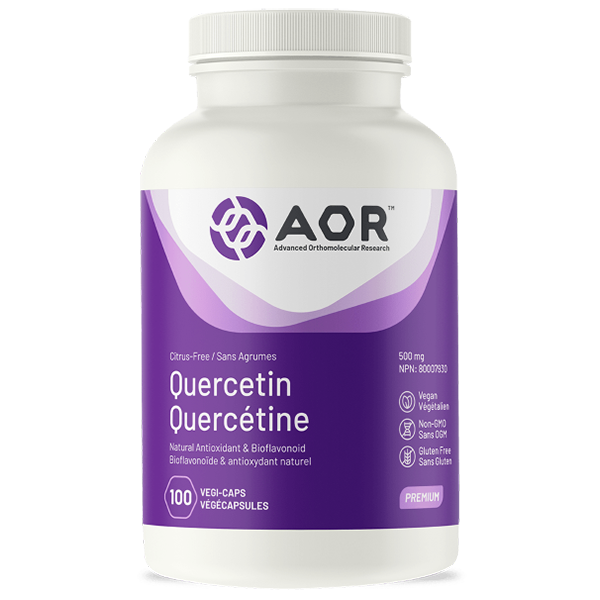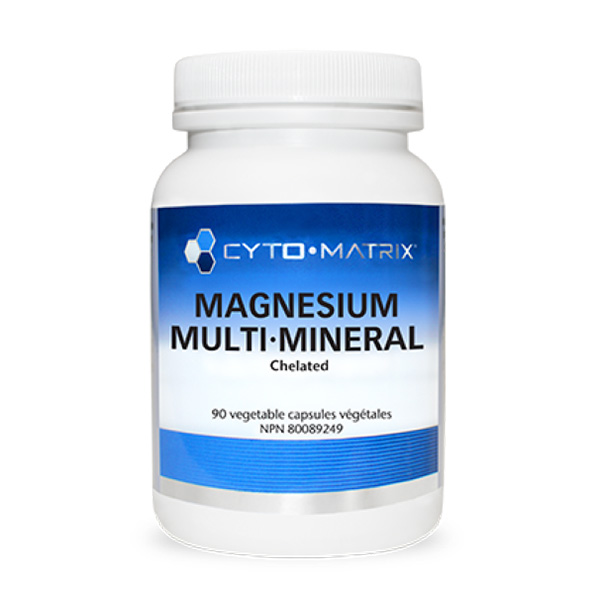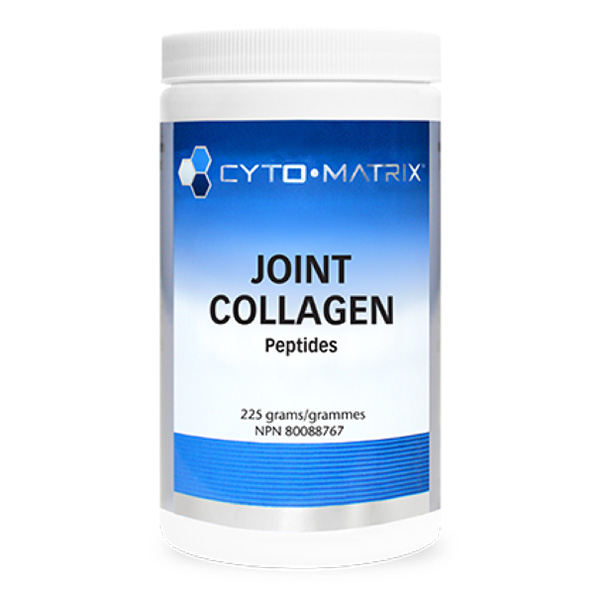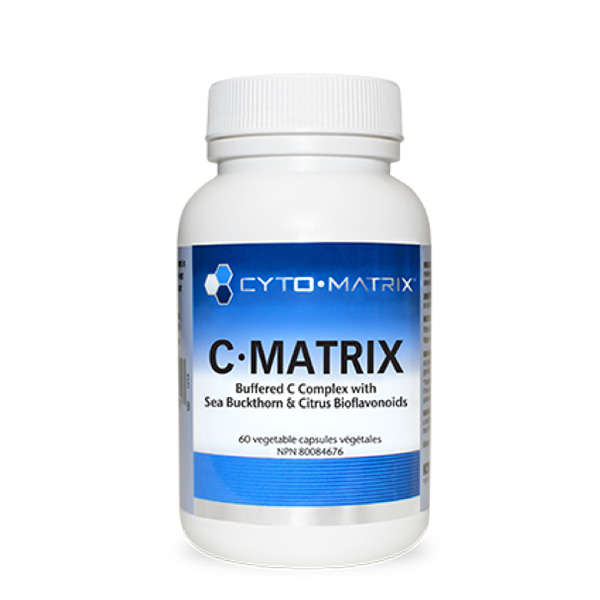Bioclinic – SAMe
$28.99
Relieves Osteoarthritic Pain
30 Enteric Coated Tablets ( SKU: 9246, NPN: 80040088 )
In stock
Benefits
- Key factor in several key biological pathways, including methylation reactions, glutathione formation and glutathione-s-transferase activity1
- Complexed with disulfate tosylate, a well-tolerated, stable, and clinically tested form
- Enteric coating protects SAMe degradation from gastric acid, allowing for significantly improved intestinal absorption
- 200 mg SAMe per tablet, allows for flexible dose titration
- SAMe is produced through a natural fermentation process that yields higher active ingredients over synthetic variations
- Suitable for vegetarians/vegans
Feature Summary
S-Adenosyl-L-Methionine (SAMe) has several critical physiological functions and is the common thread between three key metabolic pathways. Well-recognized as a unique methyl donor for more than 100 biological reactions, including DNA methylation. It also links methylation to polyamine synthesis (necessary for cell survival and growth) and transsulfuration, which is responsible for cysteine production, the rate-limiting factor in glutathione synthesis.2,3 Its unique positioning within these intersecting pathways explain its role as a regulator of redox status, cellular metabolism, proliferation, and apoptosis.4,5
Clinically, it has proven beneficial for a number of conditions, most notably osteoarthritis, fibromyalgia, neurodegenerative disease, depression, and liver disease.6,7 For patients with major depressive disorder, SAMe has been shown to be effective not only when compared to standard antidepressants, but also for selective serotonin reuptake inhibitor (SSRI) non-responders.8,9 It has also been shown to reduce the incidence of sexual dysfunction which commonly accompanies treatment with SSRI/SNRI therapy.10 SAMe has also shown efficacy for osteoarthritis comparable to NSAIDs, including celecoxib.11,12 Quite importantly, it is likely via increases in cartilage formation, glutathione production, DNA methylation, and gene expression which contribute to its efficacy, a stark contrast from pharmaceutical analgesics.13 Research also suggests benefit for neurodegenerative disease, and potentially for improving endothelial function.14-17
Medicinal Ingredients
| Each Tablet Contains: | |
| S-Adenosyl-L-Methionine (SAMe) | 200 mg |
Non-Medicinal Ingredients
Microcrystalline cellulose, coating (talc, glycerin, vegetable grade magnesium stearate (lubricant), silica, sodium
alginate), stearic acid, vegetable grade magnesium stearate (lubricant), magnesium hydroxide, silica, calcium oxide.
Allergens:
Contains no artificial colours, preservatives, or sweeteners; no dairy, starch, sugar, wheat, gluten, soy, corn, egg, fish, shellfish, salt, tree nuts, or GMOs. Suitable for vegetarians.
Recommended Use:
Recommended Adult Dose: SAMe should always be taken on an empty stomach. For mood balance: 1–4 tablets 2 times per day or as directed by a health care practitioner. For osteoarthritic pain: 1–3 tablets 2 times per day or as directed by a health care practitioner.
Do not exceed a total of 8 tablets per day. SAMe must be taken for a minimum of 2 weeks, at which time effects should be observed.
Contraindications
If you are taking antidepressants, hepatotoxic drugs or monoamine oxidase (MAO) inhibitors, consult a health care practitioner prior to taking SAMe in place of or in addition to those medications. Not recommended for use in children. Do not use if you are pregnant or breastfeeding. Do not take at night as SAMe may cause anxiety, restlessness and insomnia. People with bipolar disorder (manic-depressive illness) should not use SAMe unless under medical supervision. Possible side effects are: mild gastrointestinal upsets (such as stomach pain, nausea, diarrhea, flatulence), anxiety, hyperactive muscle movement, insomnia and hypomania. When these side effects occur they often diminish with time or resolve with lower doses or cessation of use. There are no documented cases of allergies to SAMe. Keep out of reach of children.
Drug Interactions
Deficiency of vitamins B6, B12, and other methyl donors may exacerbate SAMe deficiency. Theoretically, may have additive serotonergic effects when used with antidepressants, but when used simultaneously, no increase in adverse effects were noted compared to placebo.8
- Tchantchou, F., Graves, M., Falcone, D., et al. (2008). S-adenosylmethionine mediates glutathione efficacy by increasing glutathione S-transferase activity: implications for S-adenosyl methionine as a neuroprotective dietary supplement. J Alzheimers Dis, 14(3), 323-28.
- Park, L.K., Friso,S., &Choi,S.W. (2012). Nutritional influences on epigenetics and age-related disease. Proc Nutr Soc, 71(1), 75-83.
- Martínez-López, N., Varela-Rey, M., Ariz, U., et al. (2008). S-adenosylmethionine and proliferation: new pathways, new targets. Biochem Soc Trans, 36(Pt 5), 848-52.
- Finkelstein, J.D. (2007). Metabolic regulatory properties of S-adenosylmethionine and S-adenosylhomocysteine. Clin Chem Lab Med, 45(12), 1694-9.
- Lu, S.C., &Mato, JM. (2008). S-Adenosylmethionine in cell growth, apoptosis and liver cancer. J Gastroenterol Hepatol, 23, Suppl 1, S73-7.
- Bottiglieri, T. (2002). S-Adenosyl-L-methionine (SAMe): from the bench to the bedside–molecular basis of a pleiotrophic molecule. Am J Clin Nutr, 76(5), 1151S-7S.
- Jacobsen, S., Danneskiold-Samsøe, B., &Andersen, R.B. (1991). Oral S-adenosylmethionine in primary fibromyalgia. Double-blind clinical evaluation. Scand J Rheumatol, 20(4), 294-302.
- Papakostas, G.I. Mischoulon, D., Shyu, I., et al. (2010). S-adenosyl methionine (SAMe) augmentation of serotonin reuptake inhibitors for antidepressant nonresponders with major depressive disorder: a double-blind, randomized clinical trial. Am J Psychiatry, 167(8), 942-8.
- Williams, A.L., Girard, C., Jui, D., et al. (2005). S-adenosylmethionine (SAMe) as treatment for depression: a systematic review. Clin Invest Med, 28(3), 132-9.
- Dording, C.M., Mischoulon, D., Shyu, I., et al. (2012). SAMe and sexual functioning. Eur Psychiatry, 27(6), 451-454.
- Kim, J., Lee, E.Y., Koh, E.M., et al. (2009). Comparative clinical trial of S-adenosylmethionine versus nabumetone for the treatment of knee osteoarthritis: an 8-week, multicenter, randomized, double-blind, double-dummy, Phase IV study in Korean patients. Clin Ther, 31(12), 2860-72.
- Najm, W.I., Reinsch, S., Hoehler, F., et al. (2004). S-adenosyl methionine (SAMe) versus celecoxib for the treatment of osteoarthritis symptoms: a double-blind cross-over trial. [ISRCTN36233495]. BMC Musculoskelet Disord, 5(1), 6.
- Hosea Blewett, H.J. (2008). Exploring the mechanisms behind S-adenosylmethionine (SAMe) in the treatment of osteoarthritis. Crit Rev Food Sci Nutr, 48(5), 458-63.
- Shea, T.B., & Chan, A. (2008). S-adenosyl methionine: a natural therapeutic agent effective against multiple hallmarks and risk factors associated with Alzheimer’s disease. J Alzheimers Dis, 13(1), 67-70.
- Sharma, A., Gerbarg, P., Bottiglieri, T., et al. (2017). S-Adenosylmethionine (SAMe) for Neuropsychiatric Disorders: A Clinician-Oriented Review of Research. J Clin Psychiatry, 78(6), e656-e667.
- Román, G.C. Mancera-Páez, O., &Bernal, C. (2019). Epigenetic Factors in Late-Onset Alzheimer’s Disease: MTHFR and CTH Gene Polymorphisms, Metabolic Transsulfuration and Methylation Pathways, and B Vitamins. Int J Mol Sci, 20(2), 319.
- Gao, J., Cahill, C.M., Huang, X., et al. (2018). S-Adenosyl Methionine and Transmethylation Pathways in Neuropsychiatric Diseases Throughout Life. Neurotherapeutics, 15(1), 156-175.
| Weight | 0.1 kg |
|---|

